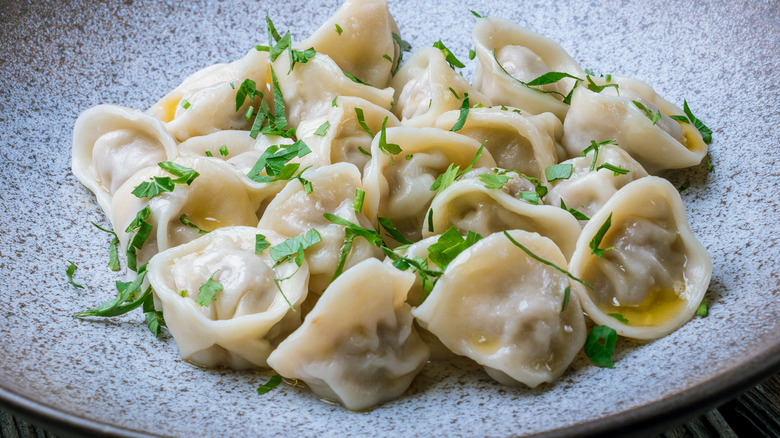The Possible Chinese Origins Of Russian Pelmeni
Mankind's affinity for dumplings seems to have no borders. Dumplings are found all over the world; taste buds are tantalized by Argentinian empanadas, Chinese soup dumplings, Polish pierogis, Italian ravioli, and Indian samosas, just to name a handful. Pockets of dough filled with sweet or savory fillings, then boiled or fried seem to bring a special kind of comfort and satisfaction that appeal to people of all ages and nationalities. Russia's dumplings — pelmeni — are found in practically every restaurant and household. Essentially, pelmeni are small, round dough pockets that are filled with meat and boiled, according to Mom's Dish.
Pelmeni are usually served with butter and sour cream or in their cooking liquid which becomes a flavorful broth (via Russiapedia). Today, you can find pelmeni frozen at farmer's markets and grocery stores, but before mass production and electricity made these things possible, families in Siberia would gather to make huge quantities of pelmeni because they can be easily prepared and preserved during long Siberian winters. In lieu of freezers, people would place bags of pelmeni outside during the winter months, a practice still sometimes used today. Although unique and mostly associated with Russia, it is believed that pelmeni are not inherently Russian, but were brought to the region by a neighboring country.
Thank Mongolia for pelmeni
While it's unclear exactly when pelmeni became a Russian food, but many believe they originated in China and were brought to the country by Mongolians who came to settle there, per Russiapedia. It's believed that at some point during their conflicts with China, Mongolians absorbed the delicious treats into their own cuisine and brought the dish into Siberia and the Urals. Eventually, the dumplings would continue to spread as far as Eastern Europe. The fact that many ingredients in pelmeni are not native to Russia, and have to be imported lends credence to this theory, and the name "pelmeni" bolsters the claim too.
The word "pelmeni" itself comes from the word "pel'nyan'," which means "ear bread" in the native Komi and Mansi languages of the region. History says that a man named Zhang Zhongjian may have invented stuffed dumplings in China during the Han Dynasty. Legend has it that he discovered the citizens of his hometown had developed frostbite around their ears, and to battle the issue, he fed them ear-shaped pieces of dough stuffed with meat and herbs. Whether this tale is true or not, it certainly could be the reason behind the name in Russian.
Kitchn explains a variety of meat can be used in filling pelmeni, like pork, beef, lamb, chicken, or fish, and that mushrooms are a good meat-free alternative, but Russiapedia says that a true pelmeni would never be stuffed with something sweet. Today, pelmeni are still made and enjoyed during cold months because of their warm, filling nature. They continue to be made in mass quantities, although inventions such as pelmeni molds have sped up the preparation process significantly, which just means more of this delightful globe-trotting dumpling for the world to discover and enjoy.

